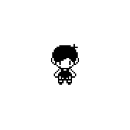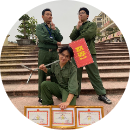Hãy đóng giả Nick và viết 1 email giử cho Hà , nói về phong tục tâp quán ở gia đình em .

Những câu hỏi liên quan
Hãy đóng giả Nick và viết 1 email giử cho Hà , nói về phong tục tâp quán ở gia đình em .
Bằng tiếng anh nhé ! ![]()
cần gì phải đóng giả ních ko ghỉ tế là :
" Hãy nói về phong tục tập quán ở gia đình bạn bằng tiếng anh "
ghi như cậu chắc ko có ai hiểu nổi ![]()
Đúng 0
Bình luận (2)
The Culture of Vietnam is one of the oldest of such in the Southeast Asia region. Although Vietnam lies geographically in Southeast Asia, long periods of Chinese domination and influence has resulted in the emergence of many East Asian characteristics in Vietnamese culture, and generally Vietnam is said to be part of the East Asian cultural sphere, known widely as Chinese cultural sphere.
Despite considerable foreign influence, Vietnamese people have managed to retain many distinct native customs which have always played a vital role in daily Vietnamese life throughout the millennia. While Chinese culture has the largest foreign influence on traditional Vietnamese culture, there is also a much smaller influence from the Cham and later Western cultures (most notably that of France, Russia and the United States).
In terms of prehistory, most Vietnamese historians consider the ancient Dong Son culture to be one of the defining aspects of early Vietnamese civilization.
The beauty of women dressed in ao dai always leaves a deep impression on foreign visitors to Vietnam. Girl students dressed in white long robes take to streets on the way to schools or back home, or gracefully sail on their bikes along streets. Female secretaries in delicate pastels greet you at an office door and older ladies in deep shades of purple, green or blue cut a striking pose at a restaurant dinner. The ao dai appears to flatter every figure.
Its body-hugging top flows over wide trousers that brush the floor. Splits in the gown extend well above waist height and make it comfortable and easy to move in. Although virtually the whole body is swathed in soft flowing fabric, these splits give the odd glimpse of a bare midriff, making the outfit very sensual.
Ao dai is made individually to fit each customer's shape to create the most graceful possible look. The pants should reach the soles of the feet and flow along the floor.
Comfortability is always taken into account for fashions and beauty. Tailoring must ensure the wearer's freedom of movements. Despite it is a long robe, ao dai must be cool to wear. Synthetic or silk fabrics are preferred as they do not crush and are quick drying, making the ao dai a practical uniform for daily wear.
The color is indicative of the wearer's age and status. Young girls wear pure white, fully-lined outfits symbolizing their purity. Older but unmarried girls move into soft pastel shades. Only married women wear ao dai in strong, rich colors, usually over white or black pants. However, ao dai is rarely seen in places where manual work is practiced. The nineties saw a real resurgence of ao dai. It has become standard and common attire for girl students as well as female staff at offices and hotels. Traditionally, ao dai has become the most preferred dress on formal occasions.
Early versions of the ao dai date back to 1744 when Lord Vu Vuong of the Nguyen Dynasty decreed both men and women should wear an ensemble of trousers and a gown that buttoned down the front. However, not until 1930 did ao dai appear partly similar to its look today. Vietnamese fashion designer-cum-tailor Cat Tuong, called as Monsieur Le Mur by the French at that time, lengthened the top so it reached the floor, fitted the bodice to the curves of the body, and moved the button line from the front to the left side of the body. Men wore it less, generally only on ceremonial occasions such as weddings or funerals. But it took another 20 years before the next major design change was incorporated and the modern ao dai emerged. During the 1950s two tailors in Saigon, Tran Kim of Thiet Lap shop and Dung of a tailoring shop of the same name, started producing ao dai with raglan sleeves. This creates a diagonal seam running from the collar to the underarm and this style is still preferred today.
Today, ao dai has been a bit modified. Its length is cut shorter usually just below the knee. Variations in the neck, between boat and mandarin style, are common and even adventurous alterations such as a low scooped neckline, puffed sleeves or off the shoulder designs are appearing as ladies experiment with fashion. Color patterns are no longer rigidly controlled and accesses to new fabrics have generated some dazzling results. However, most visitors to Vietnam have highly appreciated local tailors' skills when making ao dai. It is hard to think of a more elegant, demure and charming outfit, that suits Vietnamese women of different ages, than ao dai.
Holidays or other Important Days Vietnam celebrates many holidays, including traditional holidays which have been celebrated in Vietnam for thousands of years, along with modern holidays imported predominantly from western countries.
Among the traditional holidays, the two most important and widely celebrated are the Lunar new year (Tết), followed by the Mid-autumn lantern festival (Tết Trung Thu), although the latter has been losing ground in recent years.
Despite considerable foreign influence, Vietnamese people have managed to retain many distinct native customs which have always played a vital role in daily Vietnamese life throughout the millennia. While Chinese culture has the largest foreign influence on traditional Vietnamese culture, there is also a much smaller influence from the Cham and later Western cultures (most notably that of France, Russia and the United States).
In terms of prehistory, most Vietnamese historians consider the ancient Dong Son culture to be one of the defining aspects of early Vietnamese civilization.
The beauty of women dressed in ao dai always leaves a deep impression on foreign visitors to Vietnam. Girl students dressed in white long robes take to streets on the way to schools or back home, or gracefully sail on their bikes along streets. Female secretaries in delicate pastels greet you at an office door and older ladies in deep shades of purple, green or blue cut a striking pose at a restaurant dinner. The ao dai appears to flatter every figure.
Its body-hugging top flows over wide trousers that brush the floor. Splits in the gown extend well above waist height and make it comfortable and easy to move in. Although virtually the whole body is swathed in soft flowing fabric, these splits give the odd glimpse of a bare midriff, making the outfit very sensual.
Ao dai is made individually to fit each customer's shape to create the most graceful possible look. The pants should reach the soles of the feet and flow along the floor.
Comfortability is always taken into account for fashions and beauty. Tailoring must ensure the wearer's freedom of movements. Despite it is a long robe, ao dai must be cool to wear. Synthetic or silk fabrics are preferred as they do not crush and are quick drying, making the ao dai a practical uniform for daily wear.
The color is indicative of the wearer's age and status. Young girls wear pure white, fully-lined outfits symbolizing their purity. Older but unmarried girls move into soft pastel shades. Only married women wear ao dai in strong, rich colors, usually over white or black pants. However, ao dai is rarely seen in places where manual work is practiced. The nineties saw a real resurgence of ao dai. It has become standard and common attire for girl students as well as female staff at offices and hotels. Traditionally, ao dai has become the most preferred dress on formal occasions.
Early versions of the ao dai date back to 1744 when Lord Vu Vuong of the Nguyen Dynasty decreed both men and women should wear an ensemble of trousers and a gown that buttoned down the front. However, not until 1930 did ao dai appear partly similar to its look today. Vietnamese fashion designer-cum-tailor Cat Tuong, called as Monsieur Le Mur by the French at that time, lengthened the top so it reached the floor, fitted the bodice to the curves of the body, and moved the button line from the front to the left side of the body. Men wore it less, generally only on ceremonial occasions such as weddings or funerals. But it took another 20 years before the next major design change was incorporated and the modern ao dai emerged. During the 1950s two tailors in Saigon, Tran Kim of Thiet Lap shop and Dung of a tailoring shop of the same name, started producing ao dai with raglan sleeves. This creates a diagonal seam running from the collar to the underarm and this style is still preferred today.
Today, ao dai has been a bit modified. Its length is cut shorter usually just below the knee. Variations in the neck, between boat and mandarin style, are common and even adventurous alterations such as a low scooped neckline, puffed sleeves or off the shoulder designs are appearing as ladies experiment with fashion. Color patterns are no longer rigidly controlled and accesses to new fabrics have generated some dazzling results. However, most visitors to Vietnam have highly appreciated local tailors' skills when making ao dai. It is hard to think of a more elegant, demure and charming outfit, that suits Vietnamese women of different ages, than ao dai.
Holidays or other Important Days Vietnam celebrates many holidays, including traditional holidays which have been celebrated in Vietnam for thousands of years, along with modern holidays imported predominantly from western countries.
Among the traditional holidays, the two most important and widely celebrated are the Lunar new year (Tết), followed by the Mid-autumn lantern festival (Tết Trung Thu), although the latter has been losing ground in recent years.
Đúng 0
Bình luận (0)
viết 1 đoạn hội thoại bằng tiếng anh về
1)phong tục tập quán gia đình việt nam 2) lễ hội ở việt nam
mọi người ơi giúp em với ạ mai em phải nộp r
1.
In my opinion, customs and traditions are very important. Like other families, we have our own customs and traditions. Firstly, there's a tradition in our family of getting together on the first day of Tet. Everyone has tobe there throughout the day. We share every thing with my family members. Secondly, we have the custom of doing morning exercise at 5 a.m together. We always get up early and follow this customs. Thanks to doing morning exercise, we have good health. Thirdly, we visit the pagoda on the first day of every lunar month. This custom is that we have to buy fruit or incense for the pagoda each year. This year, we also prepared five-coloured sticky rice and worshipped Buddha. We all enjoy these customs and traditions because they provide our family with a sense of belonging.
Đúng 1
Bình luận (0)
2.
Tet is a national and family festival. It is an occasion for every Vietnamese to have a good time while thinking about the last year and the next year. At Tet, spring fairs are organized, streets and public buildings are brightly decorated and almost all shops are crowded with people shopping for Tet. At home, every is tidied, special food is cooked, offerings of food, fresh water, flowers and betel are made on the family altar with burning joss- sticks scenting the air. First-footing is made when the lucky visitor comes and children are given lucky money wrapped in a red tiny envelope. Tet is also a time for peace and love. During Tet, children often behave well and friends, relatives and neighbors give each other best wishes for the new year.
Đúng 0
Bình luận (1)
viết 1 đoạn hội thoại bằng tiếng anh về
1)phong tục tập quán gia đình việt nam 2) lễ hội ở việt nam
mọi người ơi giúp em với ạ mai em phải nộp r
viết 1 đoạn hội thoại bằng tiếng anh về
1)phong tục tập quán gia đình việt nam 2) lễ hội ở việt nam
mọi người ơi giúp em với ạ mai em phải nộp r
chỉnh lại đi bạn ơi . ko phải môn toán
6. Đóng vai là nhà sử học và tuyên truyền viên, em hãy chia sẻ với gia đình, bạn bè qua hòm thư điện tử (email) hoặc trang cá nhân (facebook) về những giá trị văn hoá mà người Việt còn lưu giữ trong thời kì chống phong kiến phương Bắc
Ngọc Anh thân mến!
Kể từ ngày mình chuyển hướng sang nghiên cứu Lịch sử và Ngọc Anh trở thành một nhà báo mình cảm thấy thật sự rất vui. Nghe nói Ngọc Anh đang có đề tài về văn hóa Việt Nam trong lịch sử, đây cũng chính là vấn đề mình đang tìm hiểu. Hi vọng một số thông tin mình gửi cho Ngọc Anh có thể giúp Mai một phần nào trong đề tài của mình. Ngay từ những ngày đầu xâm chiếm nước ta, các thế lực thực dân phương Bắc đã không ngừng thực hiện mọi thủ đoạn để bóc lột nhân dân ta, đồng hóa về văn hóa nhân dân ta. Họ đưa người Hán sang sống cùng ta, đưa người Hán sang để cai quản nhân dân ta đến tận cấp huyện. Họ mở trường dạy chữ Hán, truyền bá Nho giáo, Đạo giáo và bắt nhân dân ta phải ăn mặc theo phong tục, tập quán của họ... Đây thục sự là những chính sách tàn bạo vô cùng thủ đoạn, dã man. Nhưng người dân Việt với bản lĩnh và sự sáng tạo của mình đã không bị đồng hóa. Thay vào đó, họ đã tiếp thu những tinh hoa văn hóa, những cái mới cái tốt, cải biến làm phong phú hơn nền văn hóa dân tộc. Ở trong các làng xã, nhân dân ta vẫn sử dụng tiếng nói của tổ tiên và sinh hoạt theo nếp sống riêng, duy trì và phát huy những phong tục cổ truyền của người Việt. Chính vì thế mà nhiều phong tục tập quán vẫn được giữ gìn đến tập ngày nay như trống trong các lễ hội, ăn trầu, thờ cúng tổ tiên, các anh hùng dân tộc... Sở dĩ những chính sách đồng hóa của các triều đại phong kiến phương Bắc đã bị thất bại bởi chúng ta có làng, có xóm và thực dân phương Bắc không thể phá vỡ kết cấu làng và những quy tác, luật lệ trong làng. Ngoài ra, chúng ta có truyền thống yêu nước chống giặc ngoại xâm, không ngừng đấu tranh để bài trừ thực dân phong kiến phương Bắc. Trên đây là những thông tin cơ bản cơ bản nhất về sự tiếp biến văn hóa Việt Nam trong thời Bắc thuộc. Hi vọng với những thông tin cơ bản này, Ngọc Anh có thể tìm hiểu kĩ hơn về văn hóa Việt Nam trong lịch sử. Nếu Ngọc Anh cần thêm thông tin hãy liên hệ với mình nhé!
Đúng 2
Bình luận (1)
Viết một bài viết về phong tục tập quán của người Hà Nội xưa và nay.(no copy mạng)
Xem thêm câu trả lời
Hãy nói 3 câu về phong tục của gia đình bạn bằng tiếng anh
As a traditional family in Vietnam, I have a big one. My family has 5 members, including Mom, Dad, Grandma, sister, and me. My mom’s name is Giang. She has long hair and black eyes. She is a teacher. My Dad’s name is Trung. He is tall and very strong. His job is doctor. For me, my mom is the most beautiful woman, and my dad is the most wonderful man. And my grandma’s name is Tam. She is 95 years old, and next 5 years, we will organize the 100th longevity wishing ceremony, and I look forward to taking part in this ceremony. Besides, another woman who I love so much is my sister. Her name is Linh. She is 26 years old, and she is a beautiful woman Mom. Now, she is living in Ha Noi capital, because of her jobs. I really love my family, and I hope that we are always together anyway.
(Giống như một gia đình truyền thống ở Việt Nam. Tôi cũng có một gia đình lớn. Gia đình tôi có 5 thành viên, bao gồm bố, mẹ, bà nội, chị gái và tôi. Mẹ tôi tên là Giang. Mẹ có mái tóc dài và đôi mắt đen. Mẹ là một giáo viên. Bố tôi tên là Trung. Bố cao và rất khỏe mạnh. Công việc của bố là một bác sỹ. Đối với tôi, mẹ là người phụ nữ đẹp nhất, còn bố là người đàn ông tuyệt vời nhất. Bà nội tôi tên là Tám. Năm nay bà 95 tuổi, và trong 5 năm tới, chúng tôi sẽ tổ chức lễ mừng thọ 100 tuổi của bà, tôi rất mong chờ để tham gia lễ mừng thọ này. Ngoài ra, một người phụ nữ khác mà tôi rất yêu quý, đó chính là chị gái tôi. Chị tên là Linh, chị 26 tuổi, và là một người phụ nữ xinh đẹp như mẹ. Hiện tại, chị sống ở thủ đô Hà Nội để làm việc. tôi thực sự rất yêu quý gia đình mình, và tôi hy vọng rằng chúng tôi sẽ luôn luôn bên nhau cho dù thế nào đi nữa).
học tốt
Đúng 0
Bình luận (0)
make chung cake in the tet
clean the house every day
decorate the house in the tet
Đúng 0
Bình luận (0)
nói về phong tục mà
có phải là giới thiệu về gia đình đâu
Đúng 0
Bình luận (0)
Xem thêm câu trả lời
Hãy nói về gia đình bạn Hà và gia đình bạn An.
Tham khảo:
Gia đình bạn Hà có hai thế hệ, gia đình bạn An có ba thế hệ.
Các thành viên trong mỗi thế hệ như sau:
- Gia đình bạn Hà: Thế hệ thứ nhất gồm có bố và mẹ bạn Hà, thế hệ thứ hai gồm bạn Hà và em bạn Hà.
- Gia đình bạn An: Thế hệ thứ nhất gồm có ông nội và bà nội bạn An, thế hệ thứ hai gồm bố và mẹ bạn An, thế hệ thứ ba gồm bạn An và em bạn An.
Đúng 1
Bình luận (0)
Mọi người ơi, có thể giúp mình viết 1 đoạn văn nói về mẹ của mình là nội trợ trong gia đình và gia đình mình làm những gì về công việc nhà bằng tiếng anh dc ko ạ, gợi ý là ( bài 1 Grammar trag 8 sgk tiếng anh 10 tâp 1 ). và viết bằng hiện tại đơn và hiện tại tiếp diễn nhé, cảm ơn mn rất nhiều và cs gấp vs e đc ko ạ





















